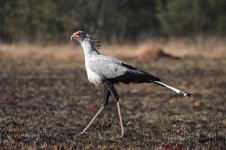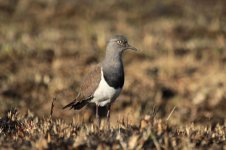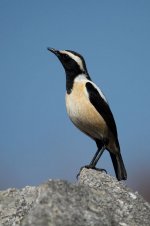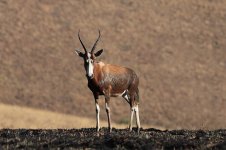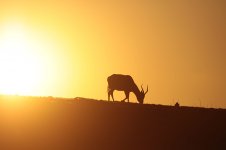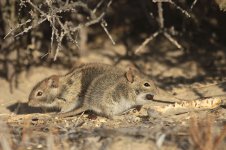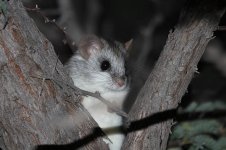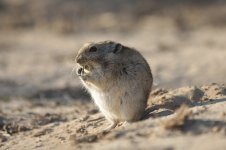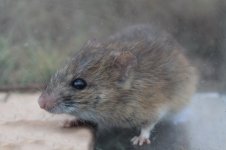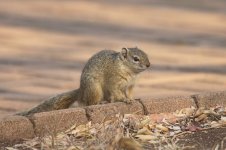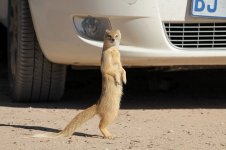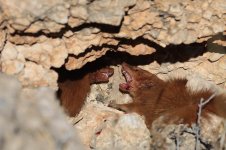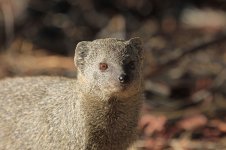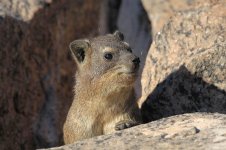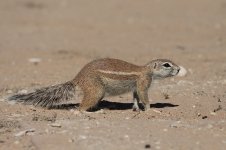
-
Welcome to BirdForum, the internet's largest birding community with thousands of members from all over the world. The forums are dedicated to wild birds, birding, binoculars and equipment and all that goes with it.
Please register for an account to take part in the discussions in the forum, post your pictures in the gallery and more.
You are using an out of date browser. It may not display this or other websites correctly.
You should upgrade or use an alternative browser.
You should upgrade or use an alternative browser.
South Africa revisited, Felines and Critters of the Night (1 Viewer)
- Thread starter Jos Stratford
- Start date
More options
Who Replied?Dave Kennedy
Well-known member
Great trip, Jos, and excellent report. Sorry to be so long in commenting, but I only found your report this afternoon. Which tells me I should look through things a little more carefully in future.
The Western Cape, Kgalagadi Transfrontier Park and Kruger/Pafuri are all favourites of mine. It's also encouraging to see a visitor taking such interest in the little things, the mongooses, Whistling Rats, Striped Mice and the like. Much of our bush work nowadays is concentrated on such things, since down through the years we have been lucky enough to have had splendid experiences with the larger animals. My best in the past couple of years have been a Smith's Rock Elephant Shrew in the Western Cape, and a Four-toed Elephant Shrew and Yellow-Spotted Rock Dassie in Pafuri.
Thanks for a first-class report.
Best wishes,
Dave
The Western Cape, Kgalagadi Transfrontier Park and Kruger/Pafuri are all favourites of mine. It's also encouraging to see a visitor taking such interest in the little things, the mongooses, Whistling Rats, Striped Mice and the like. Much of our bush work nowadays is concentrated on such things, since down through the years we have been lucky enough to have had splendid experiences with the larger animals. My best in the past couple of years have been a Smith's Rock Elephant Shrew in the Western Cape, and a Four-toed Elephant Shrew and Yellow-Spotted Rock Dassie in Pafuri.
Thanks for a first-class report.
Best wishes,
Dave

My best in the past couple of years have been a Smith's Rock Elephant Shrew in the Western Cape, and a Four-toed Elephant Shrew and Yellow-Spotted Rock Dassie in Pafuri.
Hmm, nice indeed.

27 July. Malalotja, Swaziland & Wakkerstroom.
Dawn, forlorn hopes of an Aarkvark were predictably to come to nothing, no surprise there! Instead, on a canvas of rolling grasslands, the usual herds of Blesbok, three Black-backed Jackals heading for home and the two Oribi from the day before again picking their way across a rocky slope.
A quick tootle around the reserve, adding Secretary Birds again, a couple of White-naped Ravens and both Bokmakierie and Cape White-eye around the cabin, then it was time to depart. Drove across half of Swaziland in search of a roadside stall I vaguely remembered from some years back, the reason superbly crafted furniture, perhaps the best in all Africa. Predictably failed to find it, or maybe it just doesn't exist any more, but did relocate a slightly more commercial venture, the craft centre at Swazi Candles. Proudly purchased a wooden carved Aarkvark, the ultimate critter of the night that yet again I had failed to find.
And with that, I offloaded all my unnecessary luggage to a most grateful lady near the border, then headed back into South Africa, one last little destination up my sleeve, the famous Wakkerstroom birding hotspot.
Hardly requiring an introduction, Wakkerstroom is the capital of South Africa for birds of the highland grass, the birds on offer including assorted bustards, korhaans and cranes, plus the highly localised Rudd's and Botha's Larks and Yellow-breasted Pipit. I had already visited this site a few years back, spending a few days in early summer when all the endemics and specialities were easily found, but given I was more-or-less passing, it seemed a shame to scoot by and not pop in. First up, rented a house in town that would serve as base for the night, then motored out of town to take one of the famous loops through farmland to the north. Thousands of Red-knobbed Coots and Yellow-billed Ducks, hundreds of Little Grebes, dozens of Egyptian Geese, Cape Shovelers and Southern Pochards, a few South African Shelducks, Hottentot Teals and assorted herons, ibises and cormorants, we had only driven a couple of kilometres and already an extended stop was in order! This rich veli on the edge of town also boasted African Marsh Harrier, Purple Swamphen and Black Crake, nice start.
About 10 km up, after a left turn onto a very dusty track, so started the next birding bonansa. Immense flocks of Long-tailed Widowbirds rising from roadside verges, both Yellow-crowned and Red Bishops buzzing all over the shop, loads of Pied Starlings and Cape Longclaws, Red-capped Larks appearing in abundance, no shortage of Spike-heeled Larks too. Five Swainson's Francolins scurried through rank grass, Mountain Wheatears and Sentinal Rock Thrushes perched atop mounds and broken buildings, Southern Ant-eating Chats adorned posts with great regularity. And in the midst of all of these, one Buffy Pipit, one Buff-streaked Chat, several Wing-snapping Cisticolas and an occasional Wailing Cisticola.
Also, rather strange for animals more typical of the Kalahari, loads of Meerkat and Yellow Mongoose too, any field of short turf supporting one or both. Also added several Blesbok, but truly seemed to be heading for a big zero on two of the biggest birds of the area. White-naped Ravens drifted over, two pairs of Black-winged Lapwings strutted on burnt turf and then, after the umpteenth scan, suddenly bingo on two counts, both of the big birds in a single field - two Blue Cranes and, better still, eight Blue Korhaans, simply devine.
A little more touring and by now the sun was beginning to drop, Black-headed Herons stood in a long grass field, three Grey-winged Francolins crouched at the road's edge, time tohead back to town. Did have hopes of watching the opening cermony of the London Olympics, but Wakkerstroom is not exactly the most vibrant town at night, not a single establishment was open after about 6.00 p.m.! Darn cold too, the house we stayed not very warm either! Ah well, at least the birding had been good.
Dawn, forlorn hopes of an Aarkvark were predictably to come to nothing, no surprise there! Instead, on a canvas of rolling grasslands, the usual herds of Blesbok, three Black-backed Jackals heading for home and the two Oribi from the day before again picking their way across a rocky slope.
A quick tootle around the reserve, adding Secretary Birds again, a couple of White-naped Ravens and both Bokmakierie and Cape White-eye around the cabin, then it was time to depart. Drove across half of Swaziland in search of a roadside stall I vaguely remembered from some years back, the reason superbly crafted furniture, perhaps the best in all Africa. Predictably failed to find it, or maybe it just doesn't exist any more, but did relocate a slightly more commercial venture, the craft centre at Swazi Candles. Proudly purchased a wooden carved Aarkvark, the ultimate critter of the night that yet again I had failed to find.
And with that, I offloaded all my unnecessary luggage to a most grateful lady near the border, then headed back into South Africa, one last little destination up my sleeve, the famous Wakkerstroom birding hotspot.
Hardly requiring an introduction, Wakkerstroom is the capital of South Africa for birds of the highland grass, the birds on offer including assorted bustards, korhaans and cranes, plus the highly localised Rudd's and Botha's Larks and Yellow-breasted Pipit. I had already visited this site a few years back, spending a few days in early summer when all the endemics and specialities were easily found, but given I was more-or-less passing, it seemed a shame to scoot by and not pop in. First up, rented a house in town that would serve as base for the night, then motored out of town to take one of the famous loops through farmland to the north. Thousands of Red-knobbed Coots and Yellow-billed Ducks, hundreds of Little Grebes, dozens of Egyptian Geese, Cape Shovelers and Southern Pochards, a few South African Shelducks, Hottentot Teals and assorted herons, ibises and cormorants, we had only driven a couple of kilometres and already an extended stop was in order! This rich veli on the edge of town also boasted African Marsh Harrier, Purple Swamphen and Black Crake, nice start.
About 10 km up, after a left turn onto a very dusty track, so started the next birding bonansa. Immense flocks of Long-tailed Widowbirds rising from roadside verges, both Yellow-crowned and Red Bishops buzzing all over the shop, loads of Pied Starlings and Cape Longclaws, Red-capped Larks appearing in abundance, no shortage of Spike-heeled Larks too. Five Swainson's Francolins scurried through rank grass, Mountain Wheatears and Sentinal Rock Thrushes perched atop mounds and broken buildings, Southern Ant-eating Chats adorned posts with great regularity. And in the midst of all of these, one Buffy Pipit, one Buff-streaked Chat, several Wing-snapping Cisticolas and an occasional Wailing Cisticola.
Also, rather strange for animals more typical of the Kalahari, loads of Meerkat and Yellow Mongoose too, any field of short turf supporting one or both. Also added several Blesbok, but truly seemed to be heading for a big zero on two of the biggest birds of the area. White-naped Ravens drifted over, two pairs of Black-winged Lapwings strutted on burnt turf and then, after the umpteenth scan, suddenly bingo on two counts, both of the big birds in a single field - two Blue Cranes and, better still, eight Blue Korhaans, simply devine.
A little more touring and by now the sun was beginning to drop, Black-headed Herons stood in a long grass field, three Grey-winged Francolins crouched at the road's edge, time tohead back to town. Did have hopes of watching the opening cermony of the London Olympics, but Wakkerstroom is not exactly the most vibrant town at night, not a single establishment was open after about 6.00 p.m.! Darn cold too, the house we stayed not very warm either! Ah well, at least the birding had been good.

Farewell...
28 July. Wakkerstroom.
Up early for a last zoom around the Wakkerstroom area, failed to find either Rudd's or Botha's Larks (much easier in the southern spring), didn't bother with Yellow-breasted Pipit. Did however find a few more Blue Korhaans, plus Black-winged Lapwings, Sentinal Rock Thrushes, Eastern Clapper Lark, Rattling Cisticola and flocks of Shaft-tailed Whydah. Back at the town vlei, rallidae-type birds included the oodles of Red-knobbed Coots and Common Moorhens, plus Purple Swamphen, Black Crake and African Crake. Adjacent, also found African Snipe and, in the reeds, Thick-billed Weaver, flocks of Village Weavers and a Lesser Swamp Warbler.
And with that, chucked all my gear in the car for the last time, drove to Johannesburg, seeing Grey-headed Gull on a town pool (the last addition to the trip list) and a bunch of suicidal Meerkats darting across the road. Coffee and Burger King at the airport, late afternoon fight out.
Trip over, farewell South Africa, it won't be too long before I am back!
*******************
28 July. Wakkerstroom.
Up early for a last zoom around the Wakkerstroom area, failed to find either Rudd's or Botha's Larks (much easier in the southern spring), didn't bother with Yellow-breasted Pipit. Did however find a few more Blue Korhaans, plus Black-winged Lapwings, Sentinal Rock Thrushes, Eastern Clapper Lark, Rattling Cisticola and flocks of Shaft-tailed Whydah. Back at the town vlei, rallidae-type birds included the oodles of Red-knobbed Coots and Common Moorhens, plus Purple Swamphen, Black Crake and African Crake. Adjacent, also found African Snipe and, in the reeds, Thick-billed Weaver, flocks of Village Weavers and a Lesser Swamp Warbler.
And with that, chucked all my gear in the car for the last time, drove to Johannesburg, seeing Grey-headed Gull on a town pool (the last addition to the trip list) and a bunch of suicidal Meerkats darting across the road. Coffee and Burger King at the airport, late afternoon fight out.
*******************
Trip over, farewell South Africa, it won't be too long before I am back!
*******************

Thanks for kind comments all, a final round-up of pictures. The smaller critters...
'The Little Five'
'The Little Five'
Attachments
Last edited:
edenwatcher
Well-known member
Top stuff Jos. Intrigued by your next riskier jaunt!
Rob
Rob


Top stuff Jos. Intrigued by your next riskier jaunt!
Departing Friday. Hence my scramble to finish this report :-O
Bananafishbones
Incoherently Rambling .....

Brilliant, inspirational and a trip report that you can look back on in years to come with immense satisfaction! Thanks Jos

Rather happy I have finished the writing, this report was one rather long haul! Apologies it took some time.
Full report with additional photos also on my website now, CLICK HERE
Full report with additional photos also on my website now, CLICK HERE
kitefarrago
Well-known member
Thanks for taking the time to write up the report - I thoroughly enjoyed it. Am slowly working my way through other reports on your website.
They all make me wish I had more time for travelling...
Andrea
They all make me wish I had more time for travelling...
Andrea
Thank you for sharing another wonderful adventure!
What stuns me is your ability to glide through a very diverse set of cultures and circumstances (Scandinavia, Iran South Africa) with essentially no budget or bookings, yet still achieve a level of observations that most tour managers would die for.
It would be very useful to get some insight into your planning and logistics.
Do you spend a lot of time reviewing the possible species you might find and how do you set up your itineraries? From reading your reports, one gets the impression that you have a pretty solid idea of what to expect and where, but simultaneously your schedule seems to be entirely flexible. How is that possible?
What stuns me is your ability to glide through a very diverse set of cultures and circumstances (Scandinavia, Iran South Africa) with essentially no budget or bookings, yet still achieve a level of observations that most tour managers would die for.
It would be very useful to get some insight into your planning and logistics.
Do you spend a lot of time reviewing the possible species you might find and how do you set up your itineraries? From reading your reports, one gets the impression that you have a pretty solid idea of what to expect and where, but simultaneously your schedule seems to be entirely flexible. How is that possible?
TwoDipsfromAmsterdam
Anything About?
Thank you for sharing another wonderful adventure!
What stuns me is your ability to glide through a very diverse set of cultures and circumstances (Scandinavia, Iran South Africa) with essentially no budget or bookings, yet still achieve a level of observations that most tour managers would die for.
It would be very useful to get some insight into your planning and logistics.
Do you spend a lot of time reviewing the possible species you might find and how do you set up your itineraries? From reading your reports, one gets the impression that you have a pretty solid idea of what to expect and where, but simultaneously your schedule seems to be entirely flexible. How is that possible?
Don't expect a quick answer - Jos is currently on the track of Snow Leopard in the Himalayas! Should be interesting.
David
Farnboro John
Well-known member
Don't expect a quick answer - Jos is currently on the track of Snow Leopard in the Himalayas! Should be interesting.
David
Or, of course, vice versa.....
I am sure it will be another gripping read in every way.
John
Users who are viewing this thread
Total: 2 (members: 0, guests: 2)




